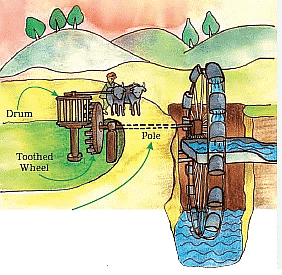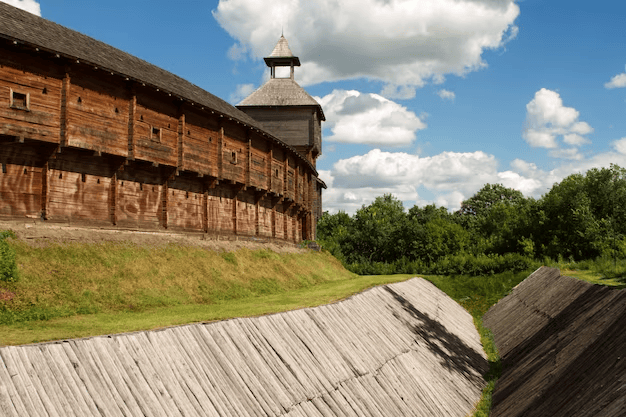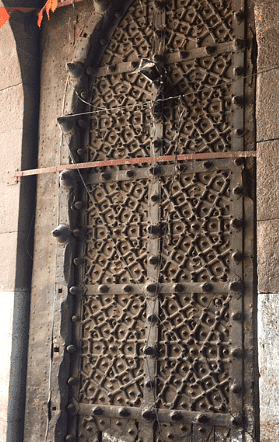Walls Tell Stories - 1 Class 5 Worksheet EVS Chapter 10
Q1: Multiple Choice Questions
(i) Where is the Golconda fort located?(a) Delhi
(b) Mumbai
(c) Hyderabad
(d) Kolkata
Ans: Hyderabad
- The Golconda Fort is located in Hyderabad.
- It is a famous historical fort known for its impressive architecture.
Golconda fort
(ii) What was the function of the sharp iron spokes on the gate?
(a) One could climb the gate in case of emergency.
(b) They made the gate look beautiful.
(c) They made gate stick to the walls.
(d) Elephants of the enemy hurt themselves if they tried to open it by butting their heads on it.
Ans: Elephants of the enemy hurt themselves if they tried to open it by butting their heads on it.
- The sharp iron spokes were designed to hurt the elephants of the enemy.
- If the elephants tried to push the gate open, they would injure themselves.
Gate of the fort
(iii) Why were the bastions made in the fort wall?
(a) To make the fort look beautiful.
(b) To keep an eye on the movement of the enemy at a distance and in different directions.
(c) For the king to rest while taking a round of the fort.
(d) They acted as the servant quarters.
Ans: To keep an eye on the movement of the enemy at a distance and in different directions.
- Bastions are projecting structures built at the corners of a fortification, usually part of the fort's outer walls.
- The bastions were built in the fort wall to provide soldiers with a strategic advantage.
- They allowed soldiers to observe enemy movements from a distance and in various directions.
- This design helped in planning defenses and coordinating attacks, ensuring better protection for the fort.
Bastions in the fort wall
(iv) Why were big holes made in the bastions?
(a) To attack the enemy without being seen
(b) To get fresh air
(c) To escape through them
(d) For the king to enjoy the scenery around the fort.
Ans: To attack the enemy without being seen
- The big holes, or firing holes, allowed soldiers to shoot at enemies without exposing themselves.
- It ensures their safety while defending the fort.
(v) What is the use of the toothed wheel in the picture? (a) To make the work of the bullocks easier.
(a) To make the work of the bullocks easier.
(b) To lift the water from the well.
(c) To change the direction of movement.
(d) To pull the water to a greater height.
Ans: To lift the water from the well.
- The toothed wheel is an important tool used in ancient water-lifting mechanisms.
- Its main function was to lift water from wells for various uses such as irrigation, drinking, and other daily needs.
- The wheel is connected to a mechanism that involves ropes or chains attached to buckets.
- When the wheel is turned, it pulls the buckets up, lifting water from the well.
Q2: Fill in the Blanks
(i) The walls of the Golconda fort are very ____________.
Ans: The walls of the Golconda fort are very thick.
- The walls of Golconda Fort are famous for their thickness, which added to the fort’s defensive strength.
- Thick walls prevented enemy attacks from easily breaking through.
- These walls helped protect the fort from powerful cannonballs and battering rams used during warfare.
 Cannon
Cannon
(ii) The Golconda fort is very ____________.
Ans: The Golconda fort is very large.
- Golconda Fort is known for its large size, covering a vast area.
- Its large size allowed the fort to accommodate palaces, water tanks, temples, and living quarters for soldiers and royalty.
- The size also ensured that the fort could house many people and resources during sieges or emergencies.
(iii) The outer wall of the fort has ____________ bastions.
Ans: The outer wall of the fort has 87 bastions
- Bastions are elevated structures built into the walls of the fort to enhance defense.
- Golconda Fort’s outer wall had 87 bastions, each providing a strategic point for soldiers to monitor enemy movements.
- The bastions were designed to help soldiers fire at attackers from various angles and directions.
(iv) The fort was made in ____________.
Ans: The fort was made in 1200 AD.
- Golconda Fort was constructed around 1200 AD and has stood the test of time, surviving numerous historical events.
- It was originally a mud fort, which was later expanded and strengthened over centuries, especially during the reign of the Qutub Shahi rulers.
(v) The walls of the fort have beautiful ____________.
Ans: The walls of the fort have beautiful carvings.
- The walls of Golconda Fort are adorned with beautiful carvings, showcasing intricate designs.
- These carvings include floral patterns, geometric designs, and inscriptions, adding to the fort’s aesthetic and cultural significance.
- The carvings reflect the artistic skills and architectural brilliance of the period in which the fort was built.
Q3: Match the Following.
Ans:
Q4: True and False
(i) Golconda Fort has very thin walls.
Ans: False
- The walls of Golconda Fort are extremely thick.
- These thick walls were built to provide better security and protection against enemy attacks.
(ii) There are many palaces inside the fort.
Ans: True
- Golconda Fort contains multiple palaces.
- These palaces were used by the royal family for living and administrative purposes.
(iii) A cannon is a big gun.
Ans: True
- Cannons are large, heavy guns.
- They were used during battles to defend the fort and to attack enemy forces.
(iv) The fort had metalled pipes to carry water to different places in the palace.
Ans: True
- The fort was equipped with a system of metalled pipes.
- These pipes helped in carrying water to different areas within the fort, ensuring a steady water supply.
(v) Mashak is a leather bag used for carrying water.
Ans: True
- A "mashak" is a traditional water-carrying bag made of leather.
- It was commonly used by people in ancient times to transport water over long distances.
Q5: Using the clues below guess the word.
(i) A subject in which we study about past. H _ _ _ _ R _
Ans: History
(ii) A part of the wall coming out in a round shape. It is built to ensure security. B _ _ T _ _ _
Ans: Bastion
(iii) A single of this can cause a lot of destruction. B _ _ _
Ans: Bomb
(iv) A place where old items are kept. M _ _ _ _ M
Ans: Museum
(v) There were beautiful B_r_ on the walls of Golconda Fort.
Ans: Burj
 Golconda Fort Map
Golconda Fort Map
Q6: Short Answer Type Questions
(i) Which sultans lived in Golconda fort?
Ans: The Qutub Shahi Sultans lived in Golconda Fort, making it their royal residence during their reign.
(ii) What does the map of Golconda fort indicate?
Ans: The map of Golconda Fort shows important locations such as the palaces, Hauz (water tank), baoli (well), Darwaza (gate), and the staircases within the fort.
(iii) Why is a deep ditch dug along the walls of the fort?
Ans: A deep ditch was dug along the fort's walls to act as a defensive barrier, preventing enemies from easily crossing and entering the fort.
 Example of deep ditch and fort
Example of deep ditch and fort
(iv) How far is Fateh Darwaza from Mahal Taramati?
Ans: The distance between Fateh Darwaza and Mahal Taramati is approximately 110 meters.
(v) In which direction would the ‘toothed wheel’ move?
Ans: The toothed wheel moves in a clockwise direction, aiding in the process of lifting water.
Q7: Long Answer Type Questions
(i) What tricks did emperors play to make smaller kingdoms a part of their own kingdom?
Ans:
- Emperors used various strategies to expand their kingdoms.
- They formed alliances through friendship with smaller kingdoms.
- They employed flattery and persuasion to win the loyalty of local rulers.
- They arranged marriage alliances to strengthen ties with other kingdoms.
- When these peaceful methods failed, emperors resorted to attacking the smaller kingdoms and taking control by force.
(ii) What do you come to know through the things kept in a museum?
Ans:
- Museums display a wide range of historical and cultural objects.
- Each object provides information about its origin, time period, and use.
- By visiting museums, people can gain a deeper understanding of different historical events, cultures, and technologies.
- Museums also help visitors improve their knowledge in specific subjects by displaying artifacts, documents, and artwork related to those fields.
(iii) Name the things that ensured the security of the fort.
Ans: Several features were incorporated into the fort's design to ensure its security, including:
- Thick walls: These made it difficult for enemies to breach the fort.
- Huge gates: The fortified gates were strong and resistant to attacks.
- Bastions: These high, rounded structures allowed soldiers to keep watch and defend the fort from a distance.
(iv) What is a bastion (burj)? What are they made for? How many bastions are there in Golconda fort?
Ans:
- A bastion (or burj) is a high, rounded structure built along the fort's outer wall.
- They were constructed to provide better defense by allowing soldiers to keep an eye on enemy movements.
- Bastions also served as lookout points for watching over a large area.
- Golconda Fort has 87 bastions spread across its walls.
(v) How would the soldiers find peeping from the holes in the bastions useful while attacking?
Ans:
- The small holes in the bastions gave soldiers an advantage during attacks.
- These holes allowed them to observe the enemy without being seen.
- They could fire weapons through the holes, which helped them target enemies more accurately.
- The design of the holes also minimized the "dead ground" (areas not visible from the fort), ensuring better protection from direct assaults.
|
53 videos|388 docs|51 tests
|
FAQs on Walls Tell Stories - 1 Class 5 Worksheet EVS Chapter 10
| 1. What is the main theme of the article "Walls Tell Stories"? |  |
| 2. How do walls communicate the stories of a place? |  |
| 3. Why is it important to preserve historical walls? |  |
| 4. Can you give examples of how walls tell stories in different cultures? |  |
| 5. How can students learn about their local history through walls? |  |



















